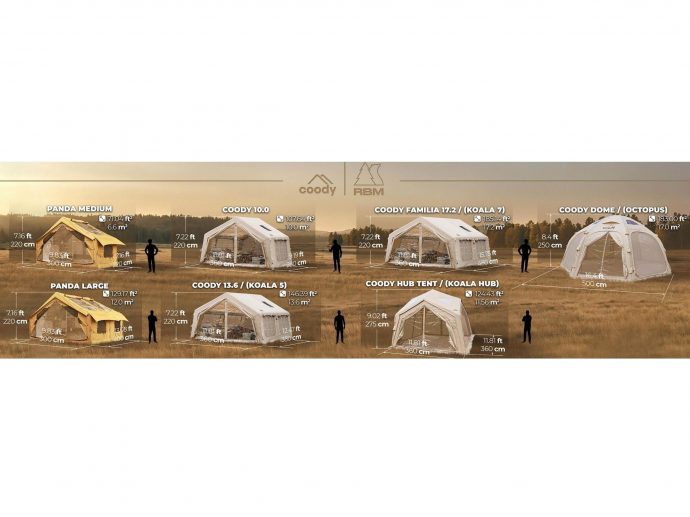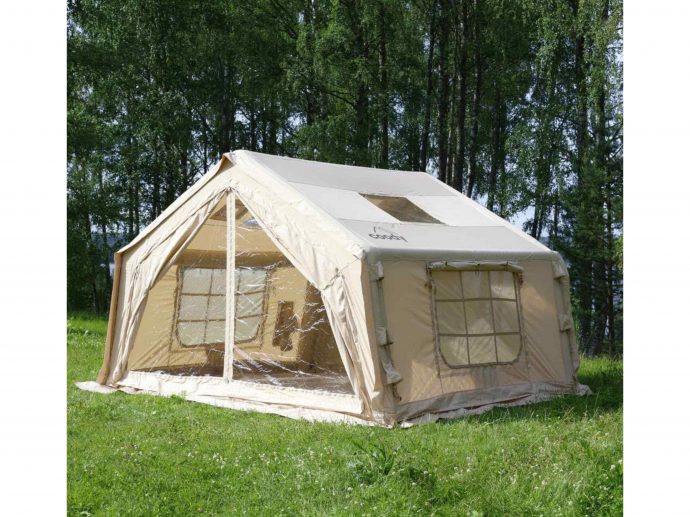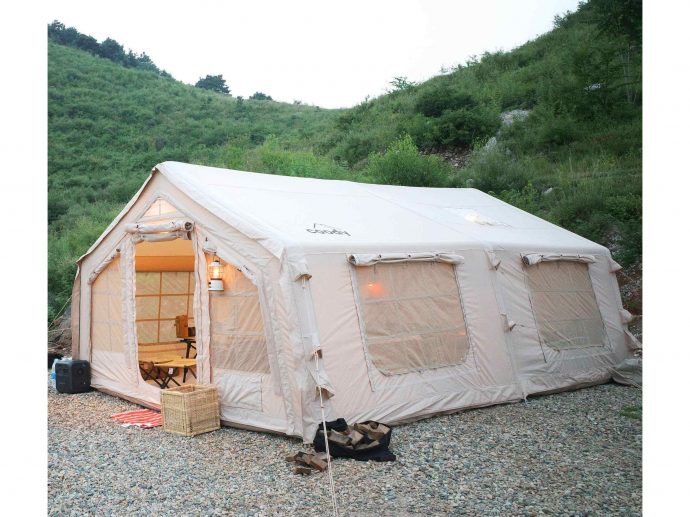Categories more
- Adventures (17)
- Arts / Collectables (15)
- Automotive (37)
- Aviation (11)
- Bath, Body, & Health (77)
- Children (6)
- Cigars / Spirits (32)
- Cuisine (16)
- Design/Architecture (22)
- Electronics (13)
- Entertainment (4)
- Event Planning (5)
- Fashion (46)
- Finance (9)
- Gifts / Misc (6)
- Home Decor (45)
- Jewelry (41)
- Pets (3)
- Philanthropy (1)
- Real Estate (16)
- Services (23)
- Sports / Golf (14)
- Vacation / Travel (60)
- Watches / Pens (15)
- Wines / Vines (24)
- Yachting / Boating (17)
Premium Inflatable Camping Tents: A Cabin-Grade Experience You Can Pack
Published
09/29/2025A new way to camp — comfort that moves with you, anywhere you park. Modern inflatable tents aren’t a festival gimmick. They’re portable, four-season shelters you can stand up in, warm up, and truly live in — without the puzzle of poles. Think cabin-level comfort, minus the cabin. That’s the idea behind Coody.
What is a premium inflatable tent?
It’s a shelter that replaces rigid metal poles with air beams. Unroll, connect the pump, inflate to working pressure — and the structure stands on its own. The goal: ease without sacrificing safety, stability, or materials quality. Coody pairs TC canvas (35% cotton / 65% polyester) with boat-grade PVC air beams and a built-in pressure-relief valve that guards against over-inflation and temperature swings.
Inflatable vs. traditional tents: what actually changes?
- Setup: minutes, not an afternoon. Even large family models go up solo with a manual or smart electric pump.
- Space: full standing height and high sidewalls, so you’re not living on your knees.
- Stability: thick, reinforced air poles absorb gusts instead of snapping like fiberglass.
- Comfort: breathable TC fabric reduces condensation and stuffiness compared to sealed poly tents.
Stand-up space, four-season flexibility, minimal setup.
Materials that make the difference
- TC Canvas (35% cotton / 65% polyester): Breathable comfort with practical water resistance; minimizes condensation vs. pure poly.
- Boat-grade PVC air beams (0.7T): Extra-thick, fire-retardant, built for real weather.
- Detachable TPU windows: Clear, insulating panels for cold-season visibility and warmth.
- Zip-in floors with raised edges: Keep water and bugs out; removable where you want an open vestibule.
Coody fabrics are tested for child-safe contact (pH-balanced, low VOC, reduced aromatic amines and nonylphenol), and structures are trialed for wind, pressure and low-temperature performance down to −40°C.
Who are premium inflatable tents for?
For anyone who wants outdoor time to feel spacious and easy. Families, overlanders, anglers and hunters use them year-round; backyard hosts turn them into guest lodges; winter campers add a stove where models include a factory stove jack. (Coody 13.6 includes a 10 cm chimney port and TPU fronts for cold seasons.)
Portability & weight
Big structures will always have mass — the difference is how they carry. Coody tents pack into manageable bags for SUVs and trailers, while mid-size models (like Coody 8.0 or 10.0) are sized for solo handling. Model weights and packages are listed below so you can match your vehicle and trip style.
How to set one up (quickly)
- Unroll and stake the corners loosely.
- Attach pump to the inflation valve.
- Inflate beams to working pressure (typ. 5–7 PSI). Pressure-relief valves prevent over-fill.
- Tension guy lines and finish staking.
- Zip in the floor (if detachable) and set your vestibule plan.
With a smart pump like the Coody CG-100, you can set target pressure, auto-stop, and even enable scheduled top-offs as temperatures drop overnight.
Choosing your Coody (size & use)
Coody 8.0 — Compact, 4-Season, 2–4 people
- Dimensions: 3.2 × 2.5 × 2.2 m (10.5 × 8.2 × 7.2 ft)
- Weight: ≈ 28 kg (62 lb); detachable floor and clear TPU options
- Best for: solo & duo trips, quick weekends, smaller vehicles
Spacious feel in a compact footprint; thick air poles with pressure relief and hotel-like interior touches.
Coody 10.0 — Everyday family base (2–4+ people)
- Dimensions: 3.6 × 2.8 × 2.2 m (11.8 × 9.2 × 7.2 ft)
- Raised-edge zip-in floor; large mesh + TPU windows
- Best for: families who want standing room and fast setup
Boat-grade beams, breathable TC, and clean geometry for easy furniture layouts.
Coody 13.6 — The four-season sweet spot (4–6 people)
- Interior: 13.6 m² / 146 ft²; height 2.2 m
- Factory stove jack (Ø 10 cm), TPU window set, rain fly included
- Best for: year-round families, glamping, longer stays
A true one-tent-does-most layout with docking zipper, partition, and big openings for summer.
Coody 17.2 Familia — Modular great-room (6–8+ people)
- Dimensions: 5.0 × 6.9 × 2.5 m (16.4 × 22.6 × 8.2 ft)
- Integrated sleeping floor + zip-in vestibule floor; five front-door modules
- Best for: big families, group camps, multi-room setups
High sidewalls (≈135 cm), 0.7T air beams, pressure relief, and docking options for hub/shelter combos.
Ventilation, condensation & cold-weather clarity
TC canvas breathes, which reduces condensation versus tightly sealed polyester. In persistent rain or very humid air, add or raise a rain fly/tarp and keep vents cracked for airflow — that’s how you stay dry and warm. Condensation itself is a natural temperature-difference effect, not a defect; ventilation solves it.
Care & maintenance (simple routine, longer life)
After wet trips
- Dry fully before storage; store in a cool, ventilated space.
- For cotton-blend tents, “seasoning” (wet/dry cycles) tightens fibers and improves water behavior over time.
Protection & setup
- Use a footprint; avoid dragging fabric on abrasive ground.
- Use guy lines in wind; keep fly tensioned so water sheds cleanly.
Why Coody stands out
- Korean design & QC: expert outdoor design, full inspection before shipping.
- Safety-first materials: child-safe textiles; fire-retardant PVC beams and floors.
- Extreme testing: wind, high-pressure, and low-temp trials (to −30° / −40°C depending on model).
- Real-world feedback: owners use Coody as a true “home from home” — for overlanding, backyard lodges, and backcountry basecamps.
Smart electric pump: set it, forget it
Coody CG-100 auto-stops at your set PSI, quietly tops off pressure overnight as temperatures drop, and alerts you to leaks or overheating. For long stays, keep it connected to power and enjoy pressure peace-of-mind.
FAQ
Do inflatable tents really handle bad weather?
Yes — thick, boat-grade beams and pressure-relief valves are designed for wind and temperature swings; fabrics are fire-retardant and mold-resistant.
What about condensation?
TC canvas breathes, reducing condensation vs. sealed poly. In humid or rainy conditions, keep vents open and fly pitched with an air gap — it’s a physics thing, not a defect.
Can I use a stove?
Use only in models with a factory stove jack and follow safe-use guidelines (ventilation, clearances, spark control). Coody 13.6 includes a 10 cm chimney port.
How long does setup take?
Typically 5–15 minutes depending on size; smart pumps automate pressure and top-offs.
Where do I start?
Browse the Coody range, compare footprints to your vehicle and group size, then talk to our team for a tailored recommendation. Many campers start with Coody 10.0 or 13.6; larger groups pick 17.2 Familia.
Final thought
If you want more time relaxing and less time assembling — and you like the idea of a breathable, warm, stand-up space that travels with you — a premium inflatable tent is a smart investment. It’s not just for a weekend; it’s for a way of living closer to what you love.



















